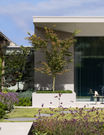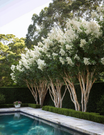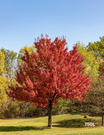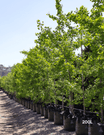When it comes to maintaining a high-end garden, mulching is one of the simplest yet most effective strategies to ensure your trees thrive and your landscape looks impeccable. For affluent gardeners who appreciate both functionality and aesthetic beauty, mulching provides a natural solution that enhances the health of trees while also boosting the visual appeal of your outdoor space. Whether you're growing ornamental flowering trees like Jacaranda mimosifolia, elegant deciduous trees like Lagerstroemia indica 'Natchez,' or privacy screens such as Syzygium paniculatum 'Backyard Bliss,' mulching is a fundamental practice that should not be overlooked.
What is Mulching?
Mulching involves spreading a layer of organic material, such as wood chips or bark, around the base of a tree. This practice improves soil quality and retains moisture and adds a polished, well-maintained look to any garden. Wealthy clients with discerning tastes and limited time can benefit from the simplicity and sophistication that mulching brings to their outdoor space.
How Mulching Improves Tree Health and Garden Appearance
Mulching provides both practical and aesthetic benefits for your garden:
- Moisture Retention: Mulch acts as an insulating layer, helping to retain moisture in the soil, which reduces the need for frequent watering—particularly useful for those with busy schedules.
- Weed Suppression: By preventing sunlight from reaching the soil, mulch reduces weed growth, which allows your trees to thrive without competition.
- Temperature Regulation: Mulch keeps the soil cooler in summer and warmer in winter, helping the roots to stay healthy in varying weather conditions.
- Nutrient Enrichment: Organic mulches break down over time, enriching the soil with nutrients that feed the trees and improve their growth.
- Enhanced Aesthetics: A well-mulched garden looks clean, sophisticated, and well-maintained, a must for luxurious landscapes.
Why Mulching is Vital for Specific Trees
Now, let's look at how mulching can directly benefit some of the most popular trees in high-end gardens, including Jacaranda mimosifolia, Lagerstroemia indica 'Natchez,' and Syzygium paniculatum 'Backyard Bliss.'
Jacaranda mimosifolia
Known for its stunning violet-blue flowers, the Jacaranda mimosifolia is a highly sought-after ornamental tree that adds a tropical, vibrant touch to gardens. Its striking display of blooms in spring and summer makes it an ideal feature tree, while its broad canopy provides shade for outdoor living spaces.
Key Facts:
- Mature Height: 10–15 meters
- Mature Width: 8–10 meters
- Best Uses: Feature tree, shade tree
- Leaf Appearance: Delicate, fern-like leaves
- Rate of Growth: Fast-growing
- Tolerates: Full sun, drought once established
Why Mulching is Essential for Jacaranda
Mulching around the base of a Jacaranda mimosifolia helps retain the moisture that this tree thrives on, especially during its first few years of growth. As a tree that can grow rapidly, it requires consistent hydration and nutrient-rich soil, both of which are supported by organic mulch. Additionally, keeping the base free from weeds through mulching will reduce competition, allowing the tree to focus on producing those iconic, vivid blooms that add undeniable luxury to any garden.
Lagerstroemia indica 'Natchez'
The Lagerstroemia indica 'Natchez' is a stately crepe myrtle known for its long-lasting white flowers and attractive bark that peels to reveal a smooth, cinnamon-colored trunk. It's a tree that offers year-round interest and is an excellent choice for wealthy clients seeking a low-maintenance yet stunning feature in their garden.
Key Facts:
- Mature Height: 7–9 meters
- Mature Width: 5–6 meters
- Best Uses: Feature tree, accent plant, seasonal color
- Leaf Appearance: Dark green leaves turning orange-red in autumn
- Rate of Growth: Moderate
- Tolerates: Heat, drought, poor soil
Why Mulching is Essential for Natchez Crepe Myrtle
Mulching helps this tree maintain an even soil temperature, particularly during extreme weather conditions. The Lagerstroemia indica 'Natchez' can tolerate poor soil, but it will perform even better when its roots are protected and insulated with a layer of mulch. By keeping the soil cooler in summer and warmer in winter, mulch supports root health, encouraging vibrant flowering in the spring and summer months. Additionally, mulching enhances the tree’s bark, creating a beautifully framed visual in any luxury garden.
Syzygium paniculatum 'Backyard Bliss'
Syzygium paniculatum 'Backyard Bliss' is an evergreen hedge tree valued for its dense, glossy foliage and compact growth habit. It’s a perfect solution for high-end clients looking for privacy or creating a lush green backdrop in their gardens. This tree requires minimal pruning, making it an excellent choice for those who value efficiency.
Key Facts:
- Mature Height: 4–6 meters
- Mature Width: 1–1.5 meters
- Best Uses: Privacy screening, hedge
- Leaf Appearance: Glossy, dark green leaves
- Rate of Growth: Fast-growing
- Tolerates: Full sun, part shade, coastal conditions
Why Mulching is Essential for Backyard Bliss
Mulching is particularly useful for maintaining Syzygium paniculatum 'Backyard Bliss' health and appearance as a privacy screen. Fast-growing trees like this require significant nutrients, and mulch helps to replenish the soil as it breaks down. A well-mulched hedge looks clean and polished and ensures the tree has the nutrients and moisture it needs to grow dense and full. Additionally, mulching helps suppress weeds that could otherwise detract from the pristine appearance of a formal hedge.
How to Apply Mulch Properly
To get the best results from mulching, it's important to follow a few key steps:
- Choose Organic Mulch: Opt for natural materials like bark chips, wood chips, or compost. These look sophisticated and break down over time, enriching the soil.
- Depth: Apply a layer of mulch 5–10 cm thick. Too much mulch can suffocate the roots, while too little may not provide enough benefits.
- Keep Away from the Trunk: Avoid piling mulch directly against the tree's trunk. Leave a small gap to prevent rot and allow the tree to breathe.
- Refresh Regularly: Organic mulch breaks down over time, so it's essential to refresh it once or twice a year to maintain its effectiveness and appearance.
FAQs About Mulching
-
How often should mulch be replaced?
Mulch should be refreshed at least once a year, ideally in spring, to maintain its effectiveness and visual appeal. -
Is mulching necessary for all trees?
While mulching benefits most trees, it's particularly important for newly planted trees, fast-growing species, and trees in hot or dry climates. -
Can mulch harm trees if applied incorrectly?
Yes, too much mulch or placing it too close to the trunk can cause root rot or invite pests. It's important to apply it properly for optimal results.
Conclusion
Mulching around trees like Jacaranda mimosifolia, Lagerstroemia indica 'Natchez', and Syzygium paniculatum 'Backyard Bliss' provides a wealth of benefits, from improving soil health to enhancing the visual appeal of your garden. For high-end clients looking to maintain a pristine and thriving landscape, mulching is an essential practice that delivers both beauty and practicality, ensuring your trees remain healthy, vibrant, and visually stunning all year round.
By incorporating mulching into your garden care routine, you can elevate the quality of your landscape with minimal effort, allowing you to enjoy a lush, well-maintained garden that reflects the luxury and sophistication of your home.


































Leave a comment
This site is protected by hCaptcha and the hCaptcha Privacy Policy and Terms of Service apply.